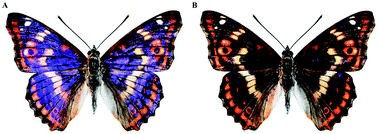The lesser purple emperor butterfly, Apatura ilia: from mimesis to biomimetics
Abstract
Until now, hues as dynamic as those adorning the Apatura emperor butterflies have never been encountered in the painting world. Unlike and unmatched by the chemical pigments traditionally found on the painter’s palette, the emperor’s wings are studded with strongly reflecting iridescent scales that are structured like those of the iconic Morpho butterflies. The scale ridges act as diffractive multilayers, giving rise to narrow-band reflectance spectra. All scales together create a vividly purple iridescent wing colouration that is observed within a narrow angular range only. Recently, synthetic structures analogous to the multilayer reflectors found on butterfly wings have been developed, referred to as effect pigments. Artists can obtain vital clues for how to adapt and adopt these challenging new materials for painting, by tracing the origin of biomimetics back to the ancient concept of mimesis and building on the knowledge accumulated by optical studies. By selecting various effect pigments, and using the lesser purple emperor butterfly, Apatura ilia, as exemplar, we have accurately mimicked the butterfly’s iridescence in art. The resulting artwork, like the butterfly, fluctuates in perceived colour depending on the direction of illumination and viewing. These nature-inspired-colouration and biomimetic-application methods extend the canon of art.

- This article is part of the themed collection: Biological and bio-inspired optics


 Please wait while we load your content...
Please wait while we load your content...